This month, HeinOnline continues its Secrets of the Serial Set series with a consideration of the origins and evolution of the American flag.
Secrets of the Serial Set is an exciting and informative monthly blog series from HeinOnline dedicated to unveiling the wealth of American history found in the United States Congressional Serial Set. Documents from additional HeinOnline databases have been incorporated to supplement research materials for non-U.S. related events discussed.
These posts have been so informative; they enable both patrons and staff to understand what the Serial Set is and how invaluable it is to all kinds of research.
The U.S. Congressional Serial Set is considered an essential publication for studying American history. Spanning more than two centuries with more than 17,000 bound volumes, the records in this series include House and Senate documents, House and Senate reports, and much more. The Serial Set began publication in 1817 with the 15th Congress, 1st session. U.S. congressional documents prior to 1817 are published as the American State Papers.
The Serial Set is an ongoing project in HeinOnline, with the goal of adding approximately four million pages each year until the archive is completed. View the current status of HeinOnline’s Serial Set project below.
The Colonial Period
The Union Jack
To thoroughly understand the evolution of the American flag, one must go back well before the American Revolution. In 1603, the ascension of James VI of Scotland to the English throne united the English and Scottish realms. In 1606, a new flag was designed to represent the union between the two, incorporating elements of both of their existing flags—Scotland’s St. Andrew’s Cross (a white saltire on a blue background) and England’s St. George’s Cross (a red cross on a white background). The flag is known today as the Union Jack.

The next year, the Kingdom of England established its first permanent colony in Jamestown, Virginia; the colony flourished, and England subsequently sponsored several more along the East coast. At this time, the new Union Jack was required to be flown by Scottish and English vessels, but was not yet required elsewhere. It wasn’t until a century later that Scotland and England agreed upon the collective name of “Great Britain,” and required that the Union Jack be used in all flags, standards, and banners on sea and on land.
Over the years following, colonists grew increasingly discontented with British rule. Without representation in Parliament, they felt that taxes and other laws undermined their constitutional rights. By the 1770s, ten of the thirteen colonies had elected representatives to form alternative governments known as Provincial Congresses. Later, 12 of the 13 colonies sent their respective delegates to the First Continental Congress in Philadelphia, Pennsylvania, leading to military response from Great Britain. Learn more about the lead-up to the American Revolution in this blog post.
The American Revolution
At sunrise on April 19, 1775, the American Revolutionary War began with the Battles of Lexington and Concord. When George Washington was elected General and Commander in Chief that July, he inherited a rag-tag group of colonial “armies” with no unifying colors or uniforms. To better organize his militia, Washington encouraged regiments to determine their own colors, and eventually, some colonies adopted their own flags (many with some representation of the number 13). Perhaps most well-known, however, is one that originated with a group of Marines in Philadelphia; they carried yellow drums adorned with a coiled rattlesnake, alongside the motto Don’t Tread on Me. Later, the design was incorporated into a flag that is said to have been adopted by Virginia. Other colonial flags included Massachusetts’, sporting a pine tree and the words An Appeal to Heaven, and Rhode Island’s, which incorporated 13 white stars on a blue background.
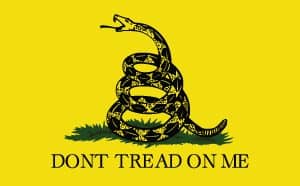
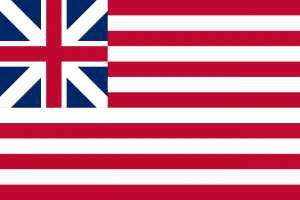
Soon after the initial battles, the Second Continental Congress convened, this time with the participation of Ben Franklin, John Hancock, and Thomas Jefferson. Over the course of the war, this Congress acted as the national government and was thus responsible for creating the Continental Army, appointing diplomats, discussing strategy, and drafting treaties. During its session, it became apparent that unifying colors were needed to represent the thirteen colonies as a whole. Likely modeled after the flag of the British East India Trading Company (which was nearly identical), a flag with thirteen alternating red and white stripes and a small Union Jack in the upper corner flew over General Washington’s headquarters at Prospect Hill by January 1, 1776.
New Colors for a New Country
Then, as independence from Great Britain became a more serious consideration, the Second Continental Congress took the time to pass a resolution specifically outlining a new flag design for the new country. Passed on June 14, 1777, the resolution stated that the flag of the United States of America would retain the 13 alternating red and white stripes, but replace the Union Jack with 13 white stars on a blue field—”representing a new constellation.” However, no particular placement or number of points was outlined for the stars, so for decades many versions of this flag existed throughout the United States.
Many have claimed credit for the design or creation of this first flag. Francis Hopkinson—a Congressman from New Jersey and a signer of the Declaration of Independence—stated multiple times that he was the original designer. Legend also has it that the design was handed to Betsy Ross by George Washington, which she subsequently sewed. Unfortunately for the Ross family, there is no supporting evidence for this claim.
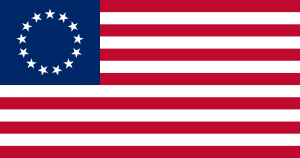
The War of 1812
America in the Middle
Within the next decade, the Kingdom of France underwent its own revolution, which Britain and other European empires viewed as another looming threat to their rule; war between Britain and France subsequently ensued. During this period, Britain made it difficult for the young United States to remain neutral, restricting international trade, seizing American ships, and engaging in impressment (compelling passengers on American ships to join the Royal Navy).
Back home, many Americans viewed this as an insult at the very least, but at worst, as evidence of further tyranny and an undermining of America’s hard-fought independence. Upon his election to the presidency in 1808, James Madison prepared for another war with Britain. The War of 1812 was formally declared on June 18—the first formal declaration of war in America’s history.
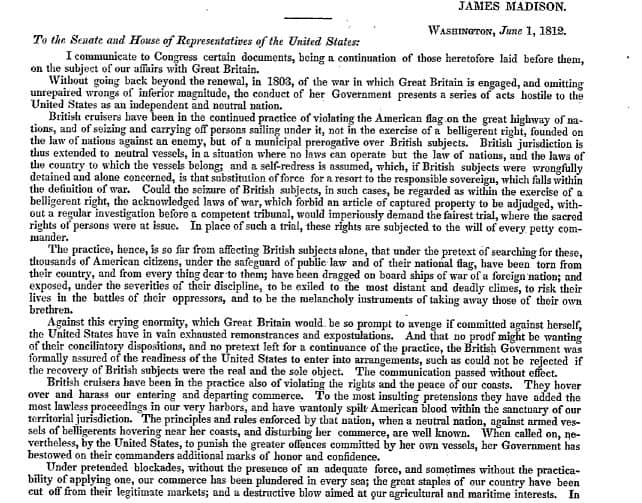
Though the U.S.-Canadian border saw most of the initial fighting, the Chesapeake Bay on the shores of Maryland, Virginia, and Delaware soon became a British target—and ultimately, a way to infiltrate the nation’s capital, Washington D.C.
At first, with Britain preoccupied with France, America saw several victories, including the Battle of Lake Erie and the defeat of Tecumseh’s Confederacy (a significant British ally) at the Battle of the Thames. By 1814, however, British victories over France freed up hundreds of British troops to send across the Atlantic Ocean. In August of that year, British forces marched on an unprepared Washington, D.C. and set multiple government buildings aflame, including the Capitol building, the White House, and the Treasury.

The Battle of Baltimore
After its success in D.C., Britain turned its eyes toward Baltimore, Maryland—a key port of entry. At the same time, Maryland lawyer Francis Scott Key had been sent to Baltimore Harbor to meet with leaders of the British military and negotiate the release of American prisoners. While there, Key became privy to British plans to attack Baltimore’s Fort McHenry, and was subsequently held captive until the attack had taken place.
On a rainy September night in 1814, Britain executed its plan—British warships bombarded Fort McHenry from the harbor for more than 24 hours while British forces attacked on land. Key, witnessing the chaos from captivity, observed that the United States flag flew magnificently over the fort all throughout the bombardment. At dawn, he awoke, knowing that the fight had ended but unaware of the outcome—that is, until he saw the American flag still flying, a sign that the British had lost.
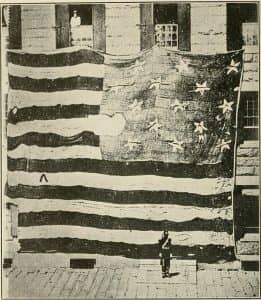
An aspiring poet, Key was moved to illustrate the events that transpired in a poem that he called “Defence of Fort McHenry.” Later, Key’s brother-in-law paired the words with a popular melody of the time, creating the song the “Star-Spangled Banner.” The image above is a photograph taken of that same flag which inspired Key, and which is still on display today at the Smithsonian National Museum of American History.
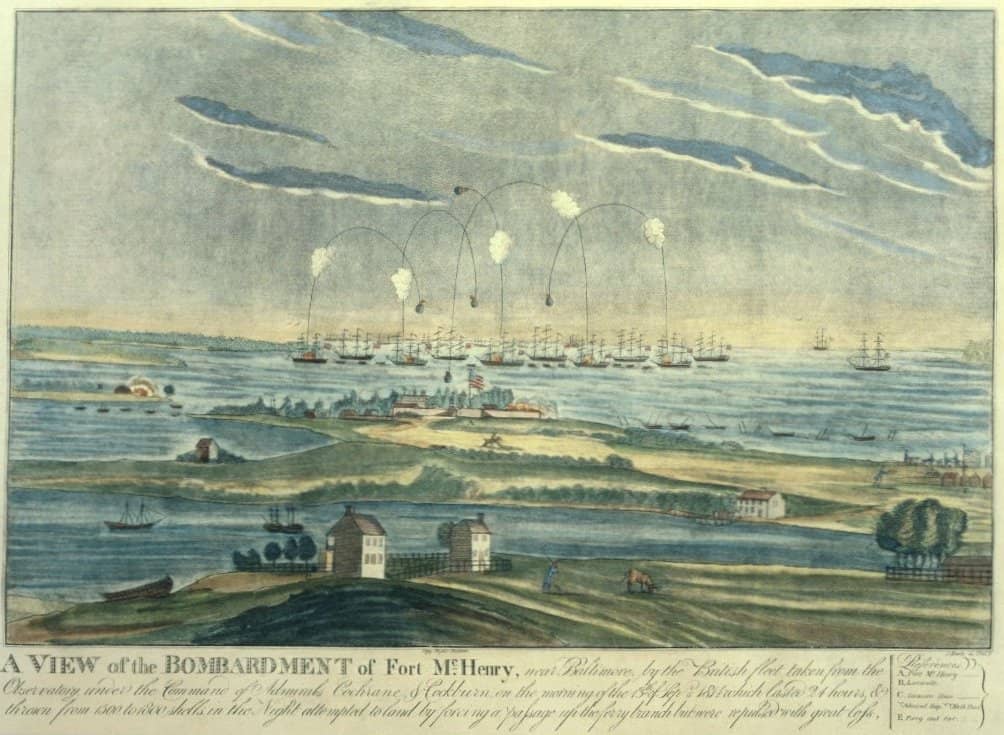
Fun Fact:
Fort McHenry’s flag was actually inspired by another that flew not far from HeinOnline’s hometown of Buffalo, New York during the war. After his transfer to Fort McHenry from the northern U.S.-Canadian border, Major George Armistead commissioned the flag that would become the Star-Spangled Banner, replicating one he had previously ordered to fly over Fort Niagara on Lake Ontario. His intention was to fly a flag over both forts that was so gigantic, the British couldn’t help but see it—even from a great distance.
The Star-Spangled Banner’s older sister still resides at Fort Niagara today, and is a prized historical artifact in Western New York.
The Civil War
Antebellum Tensions
Despite its profound effect on Francis Scott Key, the American flag was actually rarely seen at the time outside of military forts and vessels. The army was not even officially allowed to carry the flag into battle at the time of the War of 1812. Decades later, this would all change with the beginning of the Civil War.
In the years following the War of 1812, the United States saw rapid technological growth, cultural growth in the form of art and literature, and westward exploration and expansion—all leading to significant economic, political, and social changes that contributed to great polarization of the country (as evidenced by increased violence in Congress during the early nineteenth century). For decades, tensions simmered between Northern and Southern states over these very issues, and particularly the economic and human rights issue of slavery.
Abraham Lincoln, a moderate on the issue of slavery, was elected to the presidency in 1860; however, in 10 of 15 Southern slave states, not a single ballot was cast for him. Much of the South was enraged by his win, and seven states seceded that year to form the Confederate States of America, with four more states soon to join.
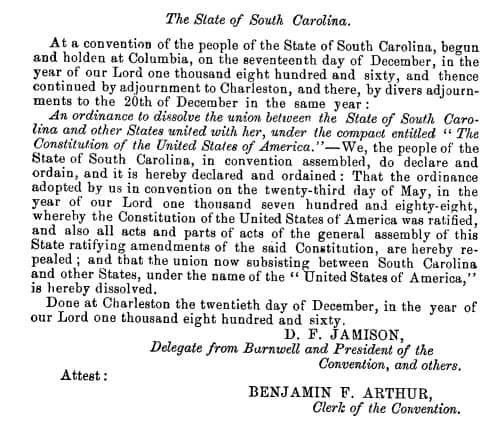
The Bombardment of Fort Sumter
Six days after South Carolina’s secession, U.S. Army Major Robert Anderson took it upon himself to relocate his company to Fort Sumter in Charleston Harbor from their previous location, Fort Moultrie. Sumter, while incomplete, was a more modern build and would be easier to defend than the nearby Moultrie if Confederate forces attacked.
Anderson and his company remained in Fort Sumter even as the now-Confederate government of South Carolina called for their evacuation. After his inauguration on March 4, President Lincoln was almost immediately confronted with the news that Major Anderson and his men only had enough food to last them until April 16. On April 4, President Lincoln ordered the shipment of supplies to Anderson and his men; however, meanwhile Confederate President Jefferson Davis, ordered that Sumter surrender or face attack before the shipment arrived. Major Anderson stood fast, and in the early morning hours of April 12, 1861, Confederate troops opened fire on the fort, officially initiating the Civil War.
Ultimately, the Union men inside the fort had to surrender. Anderson’s one condition for withdrawal was a 100-gun salute to the U.S. flag. Then, upon his retreat from the fort, he carried the flag with him North where it became a symbol of the battle that would incite Union supporters. Read this correspondence between President Lincoln and others relating to the events at Fort Sumter.
Flag-Mania Ensues
It was at this point that the American flag became part of the country’s national identity and a symbol of American patriotism. Four years later to the day, Major Anderson would return to Fort Sumter after its recapture to raise the American flag over the area once again, this time in triumph. Just hours later, President Lincoln would be assassinated by Confederate sympathizer John Wilkes Booth. Tributes of other nations following his assassination, some even quoting the words from Francis Scott Key’s 1814 poem, demonstrate the rapid globalization of the American identity, which was becoming forever intertwined with its flag.
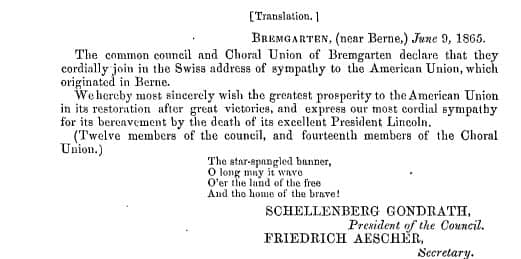
As the Civil War ended and the country approached its first centennial in 1876, legends regarding the first American flag took off, with Betsy Ross’ family claims among them.
By the late 1800s, the “flag-mania” initiated during the Civil War was still going strong. Throughout the late nineteenth century, Francis Scott Key’s Star-Spangled Banner could regularly be heard at public events. In 1892, Francis Bellamy was inspired by the flag to write the Pledge of Allegiance, which was subsequently distributed in a youth-oriented publication and would be regularly recited in American schools and at government meetings. In 1897, states began to adopt statutes prohibiting the desecration of the flag, with all states adopting some sort of flag desecration law by 1932; efforts to establish a federal law were introduced in Congress in the early 1900s, but would not succeed until decades later.
The World War Era
With significant attention being brought to the American flag, it soon became clear that there needed to be some consistent order to the stars and the stripes. Sometimes, flags displayed stripes alternating in red and then white, while others were manufactured in the opposite order. What’s more, the stars were hardly ever arranged in a consistent method, and sometimes even the design of the stars themselves differed (regarding number of points).
In 1912, to solve this problem, President William Howard Taft signed an executive order clarifying for the first time what the American flag should look like in great detail. Then, less than a year before the U.S. would enter World War I, Woodrow Wilson issued a proclamation that would officially establish nationwide observance of Flag Day on June 14, the anniversary of the Second Continental Congress’ first flag-related resolution.
Two years later, the first bill to officially recognize the “Star-Spangled Banner” as the national anthem was introduced to Congress. It was introduced at least six more times over the years until officially being accepted in 1931.
Today, the United States Flag Code exists as Chapter 1 of Title 4 of the United States Code. It outlines the role of the flag of the United States, the manner of delivery when pledging allegiance to the flag, conduct and customs surrounding respect for the flag, and more. Check it out in HeinOnline’s U.S. Code database.
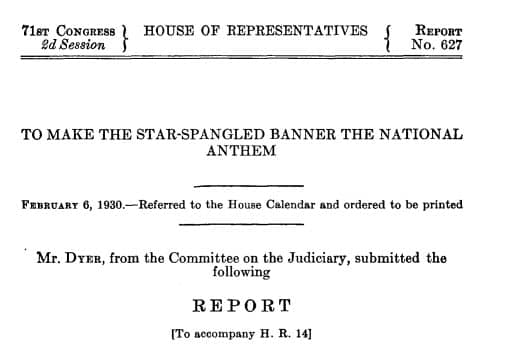
Help Us Complete the Project
If your library holds all or part of the Serial Set, and you are willing to assist us, please contact Shannon Hein at 716-882-2600 or shein@wshein.com. HeinOnline would like to give special thanks to the following libraries for their generous contributions which have resulted in the steady growth of HeinOnline’s U.S. Congressional Serial Set.
- Wayne State University
- University of Utah
- UC Hastings
- University of Montana
- Law Library of Louisiana
- George Washington University
- University of Delaware
We will continue to need help from the library community to complete this project. Download this Excel file to see what we’re still missing.



